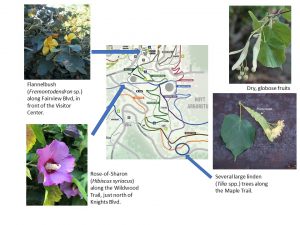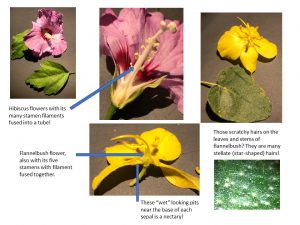Today. Right now. Or within the next two weeks or so (early August), we have a couple of marvelous examples of Malvaceae (the mallow family) in bloom for you to examine and enjoy at Hoyt Arboretum!
The Malvaceae includes well-known showy flowers such as hibiscus, hollyhocks, and checkerblooms, a few weedy members like velvetleaf and cheeseweed, and some economically important plants like okra, cotton, cacao and durian. The mallow family also includes the original “marshmallow,” which was a sweet confection eaten by Romans and Egyptians made from the root of a mallow plant, Althaea officinalis, which grows in marshy habitats.
Members of the mallow family can be herbs, shrubs or trees, often have stellate (star-shaped) or branched hairs, and mucilaginous juice. Their leaves are simple and alternately arranged, often palmately-lobed or veined, and their flowers are radially symmetrical in parts of fives. Its flowers sometimes have nectaries, and mallow family members frequently have their stamen filaments fused together into a distinctive tube.
At Hoyt Arboretum, we have six genera of Malvaceae in our collections, with Hibiscus, Fremontodendron and Tilia as our most recognized representatives. Genus Tilia are the linden trees, sometimes also called basswoods or limetrees. They often produce profuse quantities of small cream-colored fragrant flowers in mid-summer and bear small, dry globose fruits by late summer. Linden trees are frequently planted as street trees, many have distinctive elongated floral bracts, and they tend to attract many bees during flowering. A grove of linden trees at Hoyt Arboretum is located between the Maple Trail and Knights Blvd.
The most showy members of Malvaceae at the Arboretum however, are the Rose-of-Sharon (Hibiscus syriacus) and flannelbush (Fremontodendron spp.) which flower in mid-to late-summer. Our one large Rose-of-Sharon shrub is located off the Wildwood Trail, just north of where it crosses Knights Blvd (near the small aspen grove), and we have two large flannelbush plants situated right on the edge of Fairview Blvd in front of the Visitors Center.


Take a look at each of these flowers, noting their flower parts in multiples of fives and their characteristic stamens that have their filaments fused into an elongated tube. When you see this combination of character traits, you will know that you are looking at a member of the mallow family. Also, do you see their nectaries and stellate hairs? The flannelbush is covered in itchy, sandpaper-like stellate hairs, but the Rose-of-Sharon is mostly hair-less. Look at its stems or just below each flower, and you will see some stellate hairs.


Although we do not have any true “marsh mallows” at Hoyt Arboretum, we do have these few members of the mallow family for you to admire and enjoy!
About the Author


Images from:
Mandy Tu
OSU Landscape Plants
